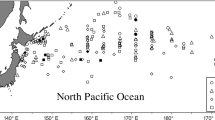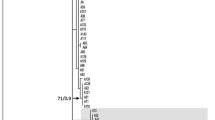Abstract
Females of the polychaete Polydora hoplura (Claparède 1869) that produced planktotrophic and adelphophagic larvae were compared genetically to determine whether the different reproductive morphs represented sibling species or poecilogony. Worms were collected from Saldanha Bay, South Africa (33°0′37.71S, 17°56′59.74E), and cultured in a laboratory setting from November 2012 to April 2013. The results based on mitochondrial and nuclear DNA (Cyt b and ATPSα, respectively) showed shared haplotypes between reproductive morphs for both markers. Additionally, variation in mtDNA sequences was significantly higher within morphs than between morphs (95.8 and 4.2 %, respectively). A comparison of developmental modes found that broods of planktotrophic larvae were larger than broods of adelphophagic larvae, while the latter had larger eggs and larvae at hatching. Developmental time from oviposition to settlement for planktotrophic and adelphophagic larvae was 40.2 and 16.6 days, respectively. Polydora hoplura represents the fifth confirmed case of poecilogony in the Spionidae.






Similar content being viewed by others
References
Blake JA, Arnofsky PL (1999) Reproduction and larval development of the spioniform Polychaeta with application to systematics and phylogeny. Hydrobiologia 402:57–106
Boore JL, Brown WM (2000) Mitochondrial genomes of Galathealinum, Helobdella and Platynereis: sequence and gene arrangement comparisons indicate that Pogonophora is not a phylum and Annelida and Arthropoda are not sister taxa. Mol Biol Evol 17:87–106
Claparède E (1869) Les Annélides Chétopodes du Golfe de Naples. Seconde partie. Annélides sédentaires. Mémoires de la Société de physique et d’histoire naturelle de Genève 20:365–542
Clement M, Posada D, Crandall K (2000) TCS: a program to estimate gene genealogies. Mol Ecol 9:1657–1660
Collin R, Spangler A (2012) Impacts of adelphophagic development on variation in offspring size, duration of development, and temperature-mediated plasticity. Biol Bull 223:268–277
Cowen RK, Sponaugle S (2009) Larval dispersal and marine population connectivity. Ann Rev Mar Sci 1:443–466
Duchêne JC (2000) Effects of poecilogony and delayed larval emission on recruitment of subantarctic population of Boccardia polybranchia. Bull Mar Sci 67:311–319
Excoffier L, Lischer HEL (2010) Arlequin suite ver 3.5: a new series of programs to perform population genetic analyses under Linux and Windows. Mol Ecol Resour 10:564–567
Giard A (1905) La Poecilogonie. Comp Rend Six Congr Int de Zool Berne 1904:617–646
Gibson GD (1997) Variable development in the spionid Boccardia proboscidea (Polychaeta) is linked to nurse egg production and larval trophic mode. Invertebr Biol 116:213–226
Gibson G, Carver D (2013) Effects of extra-embryonic provisioning on larval morphology and histogenesis in Boccardia proboscidea (Annelida: Spionidae). J Morphol 274:11–73
Gibson GD, Paterson IG, Tayler H, Woolridge B (1999) Molecular and morphological evidence of a single species, Boccardia proboscidea (Polychaeta: Spionidae), with multiple development modes. Mar Biol 134:743–751
Hall TA (1999) Bioedit: a user friendly biological sequence alignment editor and analysis program for windows 95/98/NT. Nucleic Acids Symp Ser 41:95–98
Haupt TM, Griffiths CL, Robinson TB (2012) Intra-regional translocations of epifaunal and infaunal species associated with cultured Pacific oysters Crassostrea gigas. Afr J Mar Sci 34:187–194
Hoagland KE, Robertson R (1988) An assessment of poecilogony in marine invertebrates: phenomenon or fantasy? Biol Bull 174:109–125
IBM Corp Released (2011) IBM SPSS statistics for windows, version 20.0. IBM Corp, Armonk, NY
Jablonski D, Lutz RA (1983) Larval ecology of marine benthic invertebrates: paleobiological implications. Biol Rev 58:21–89
Jarman SN, Ward RD, Elliott NG (2002) Oligonucleotide primers for PCR amplification of coelomate introns. Mar Biotechnol 4:347–355
Kamel SJ, Oyarzun FX, Grosberg RK (2010) Reproductive biology, family conflict and size of offspring in marine invertebrates. Integr Comp Biol 50:619–629
Kesaniemi JE, Rawson PD, Lindsay SM, Knott KE (2012) Phylogenetic analysis of cryptic speciation in the polychaete Pygospio elegans. Ecol Evol 2:994–1007
Knott EK, McHugh D (2012) Introduction to symposium: poecilogony—a window on larval evolutionary transitions in marine invertebrates. Integr Comp Biol 52:120–127
Levin LA (1984) Multiple patterns of development in Streblospio benedicti Webster (Spionidae) from three coasts of North America. Biol Bull 166:494–508
Levin LA (2006) Recent progress in understanding larval dispersal: new directions and digressions. Integr Comp Biol 46:282–297
Levin LA, Zhu J, Creed E (1991) The genetic basis of life history characters in a polychaete exhibiting planktotrophy and lecithotrophy. Evolution 45:380–397
McKay J, Gibson G (1999) The influence of nurse eggs on variable larval development in Polydora cornuta (Polychaeta: Spionidae). Invertebr Reprod Dev 35:167–176
Mead A, Carlton JT, Griffiths CL, Rius M (2011) Introduced and cryptogenic marine and estuarine species of South Africa. J Nat Hist 45:2463–2524
Mileikovsky SA (1971) Types of larval development in marine bottom invertebrates, their distribution and ecological significance: a reevaluation. Mar Biol 10:193–213
Moran AL, McAlister JS (2009) Egg size as a life history character of marine invertebrates: is it all it’s cracked up to be? Biol Bull 216:226–242
Oyarzun FX, Strathmann RR (2011) Plasticity of hatching and the duration of planktonic development in marine invertebrates. Integr Comp Biol 51:81–90
Oyarzun FX, Mahon AR, Swalla BJ, Halanych KM (2011) Phylogeography and reproductive variation of the poecilogonous polychaete Boccardia proboscidea (Annelida: Spionidae) along the west coast of North America. Evol Dev 13:489–503
Palmer AR, Strathmann RR (1981) Scale of dispersal in varying environments and its implications for life histories of marine invertebrates. Oecologia 48:308–318
Palumbi SR (1994) Genetic divergence, reproductive isolation and marine speciation. Ann Rev Ecol Syst 25:547–572
Pechenik JA (1999) On the advantages and disadvantages of larval stages in benthic marine invertebrate life cycles. Mar Ecol Prog Ser 177:269–297
Radashevsky VI (1994) Life history of a new Polydora species from the Kurile Islands and evolution of lecithotrophy in polydorid genera (Polychaeta: Spionidae). Ophelia 39:121–136
Rasmussen E (1973) Systematics and ecology of the Isefjord marine fauna (Denmark). Ophelia 11:1–495
Read GB (1975) Systematics and biology of polydorid species (Polychaeta: Spionidae) from Wellington Harbor. J R Soc N Z 5:395–419
Rice SA, Rice KA (2009) Variable modes of larval development in the Polydora cornuta complex (Polychaeta: Spionidae) are directly related to stored sperm availability. Zoosymposia 2:397–414
Rice SA, Karl S, Rice KA (2008) The Polydora cornuta complex (Annelida: Polychaeta) contains populations that are reproductively isolated and genetically distinct. Invertebr Biol 127:45–64
Schulze SR, Rice SA, Simon JL, Karl SA (2000) Evolution of poecilogony and the biogeography of North American populations of the polychaete Streblospio. Evolution 54:1247–1259
Simon CA (2011) Polydora and Dipolydora (Polychaeta: Spionidae) associated with molluscs on the south coast of South Africa, with descriptions of two new species. Afr Invertebr 52:39–50
Thompson JD, Higgins DG, Gibson TJ, Clustal W (1994) Improving the sensitivity of progressive multiple sequence alignment through sequence weighting, position-specific gap penalties and weight matrix choice. Nucl Acids Res 22:4673–4680
Thorson G (1950) Reproductive and larval ecology of marine bottom invertebrates. Biol Rev 25:1–45
Vance RR (1973) On reproductive strategies in marine benthic invertebrates. Am Nat 107:339–352
Walker LM (2011) A review of the current status of the Polydora-complex (Polychaeta: Spionidae) in Australia and a checklist of recorded species. Zootaxa 2751:40–62
Wilson DP (1928) The larvae of Polydora ciliata Johnston and Polydora hoplura Claparede. J Mar Biol Assoc UK 15:567–589
Wray GA, Raff RA (1991) The evolution of developmental strategy in marine invertebrates. Trends Ecol Evol 6:45–50
Acknowledgments
We thank James Blake and Jason Williams for advice on culture procedures, Glenys Gibson for valuable input, Tamara Robinson for suggestions and comments on the statistics, Sandy van Niekerk for taxonomic clarification of adult worms and Lee Gavin Williams for help with the genetic component of the study. We would like to thank Kevin Ruck for supplying oysters and Grant Pitcher and Alick Hendricks of the Department of Agriculture, Forestry and Fisheries of South Africa for supplying algae stock cultures and three anonymous reviewers for their input. The support of Stellenbosch University is also greatly appreciated. This study is part of a larger doctoral dissertation funded by the National Research Foundation (Thuthuka Programme) of South Africa.
Author information
Authors and Affiliations
Corresponding author
Additional information
Communicated by J. Grassle.
Electronic supplementary material
Below is the link to the electronic supplementary material.
Rights and permissions
About this article
Cite this article
David, A.A., Matthee, C.A. & Simon, C.A. Poecilogony in Polydora hoplura (Polychaeta: Spionidae) from commercially important molluscs in South Africa. Mar Biol 161, 887–898 (2014). https://doi.org/10.1007/s00227-013-2388-0
Received:
Accepted:
Published:
Issue Date:
DOI: https://doi.org/10.1007/s00227-013-2388-0




